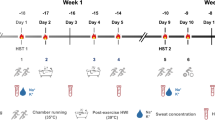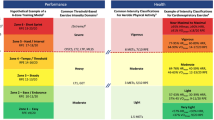Summary
The purpose of this investigation was to evaluate the effect of passive smoke inhalation on submaximal and maximal exercise performance. Eight female subjects ran on a motor driven treadmill for 20 min at 70%\(V_{O_{2\max } } \) followed by an incremental change in grade until maximal work capacity was obtained. Each subject completed the exercise trial with and without the presence of residual cigarette smoke. Compared to the smokeless trials, the passive inhalation of smoke significantly reduced maximal oxygen uptake by 0.25 1·min−1 and time to exhaustion by 2.1 min. The presence of sidestream smoke also elevated maximal R value (1.01 vs 0.93), maximal blood lactate (6.8 vs 5.5 mM), and ratings of perceived exertion (17.4 vs 16.5 units). Passive inhalation of smoke during submaximal exercise significantly elevated the CO2 output (1.68 vs 1.58 l·min−1),R values (0.91 vs 0.86), heart rate (178 vs 172 bts·min−1) and rating of perceived exertion (13.8 vs 11.8 units). These findings suggest that passive inhalation of sidestream smoke adversely affects exercise performance.
Similar content being viewed by others
References
Bonham GS, Wilson R (1981) Childrens health in families with cigarette smokers. Am J Public Health 51:290–293
Borg GA (1973) Perceived exertion: a note on history and methods. Med Sci Sports 5:90–93
Hirayama T (1981) Nonsmoking wives of heavy smokers have a higher risk of lung cancer: A study from Japan. Br Med J 282:183–185
Karlsson J (1979) Localized muscular fatigue: role of muscle metabolism and substrate depletion. Exercise Sport Sci Rev 7:1–42
Lamb DR (1984) Physiology of exercise: responses & adaptations. MacMillan Publishing Company, New York
Maksud M, Baron A (1980) Physiological responses to exercise in chronic cigarette and marajuana users. Eur J Appl Physiol 43:127–134
Olshansky ST (1982) Is smoker/nonsmoker segregation effective in reducing passive inhalation among smokers? Am J Public Health 72:737–739
Rowell LB (1969) Circulation. Med Sci Sports 1:15–22
Russell MAH (1973) Absorption by non-smokers of carbon monoxide from room air polluted by tobacco smoke. Lancet 1:576–579
Strom G (1949) The influence of anoxia on lactate utilization in man after prolonged muscular work. Acta Physiol Scand 17:440–451
White JR (1978) Effects of residual smoke on nonsmokers. In: Landry F, Orban W (eds) Exercise physiology, vol 4. Symposium Specialists, Miami, pp 529–533
Author information
Authors and Affiliations
Rights and permissions
About this article
Cite this article
McMurray, R.G., Hicks, L.L. & Thompson, D.L. The effects of passive inhalation of cigarette smoke on exercise performance. Europ. J. Appl. Physiol. 54, 196–200 (1985). https://doi.org/10.1007/BF02335929
Accepted:
Issue Date:
DOI: https://doi.org/10.1007/BF02335929




